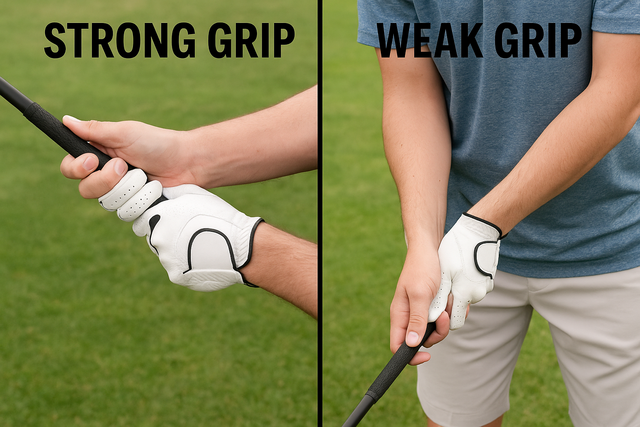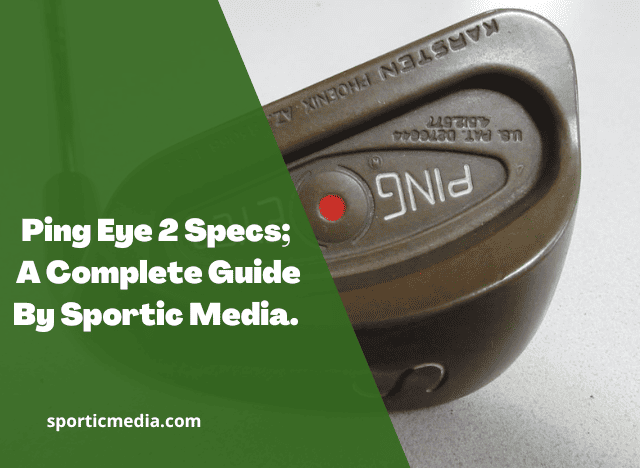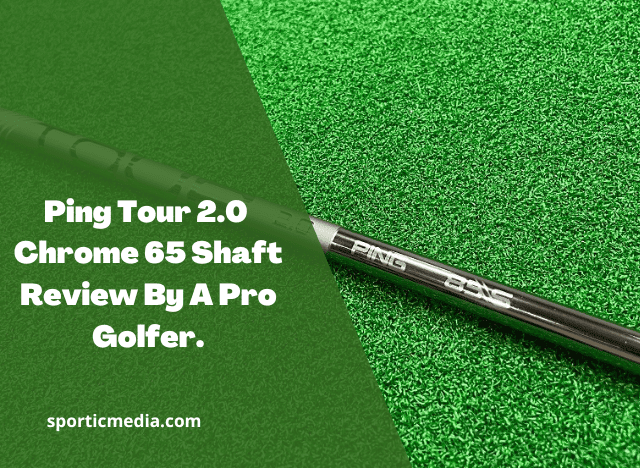Let’s talk about something that might not sound exciting but can completely transform your game – your grip. I know, I know, it’s not as flashy as talking about the latest driver or discussing perfect swing mechanics, but trust me on this one.
Your grip is literally the only connection between you and the golf club, and getting it right can be the difference between frustrated rounds and confident golf.
Think of it this way: you wouldn’t try to hammer a nail while holding the hammer by the metal head, right? The same principle applies to golf. How you hold that club determines everything that happens next.
What’s All This Talk About Strong and Weak Grips?
First things first – let’s clear up some confusion. When we say “strong” or “weak” grip in golf, we’re not talking about how tightly you squeeze the club. We’re talking about the position of your hands on the grip and how that affects your clubface at impact.
It’s kind of like adjusting the steering wheel in your car. A small change in hand position can send you in a completely different direction. In golf, these small grip adjustments can be the difference between hitting it straight down the fairway or watching your ball disappear into the woods.
A Quick Complete Comparison
🏌️ Golf Grip Comparison Guide
Master Your Grip, Master Your Game
Hand Position
V’s point toward right shoulder (righties). Left hand more “over” the grip, right hand underneath. See more left-hand knuckles.
Benefits
- Helps square/close clubface
- Reduces slice tendency
- Promotes draw shots
- Increases power & distance
Challenges
- Can cause hooks if overdone
- Harder to hit high, soft shots
- May deloft clubs
Hand Position
V’s point toward left shoulder (righties). Left hand more underneath, right hand over the grip. See fewer left-hand knuckles.
Benefits
- Promotes fade shots
- Reduces hook tendency
- Higher ball flight
- Better short game control
Challenges
- Can increase slice tendency
- Harder to generate power
- Requires good flexibility
Hand Position
V’s point toward chin/center of face. Balanced hand position offering versatility in shot-making and club control.
Benefits
- Balanced power & control
- Consistent ball flight
- Great for shot shaping
- Most versatile option
Challenges
- Harder to maintain perfectly
- May not fix specific issues
- Requires consistent practice
🎯 Which Grip is Right for You?
Choose Strong Grip If:
- You slice the ball regularly
- You want more distance
- You struggle to square clubface
- You have slower swing speed
Choose Weak Grip If:
- You hook the ball too much
- You’re an experienced player
- You love high, soft shots
- You prefer fade ball flight
Choose Neutral Grip If:
- You hit fairly straight shots
- You want maximum versatility
- You’re developing fundamentals
- You’re unsure which to pick
🤝 Grip Pressure Scale
How tightly should you hold the club? Find your sweet spot!
Club slips
Firm & relaxed
Tense & rigid
The Strong Grip: Your Anti-Slice Medicine
Let’s start with the strong grip, which is probably going to be your best friend if you’re one of those golfers who watch their ball curve to the right every single time (that’s a slice, by the way).
How to Do It?
Here’s how you set up a strong grip:
When you look down at your hands on the club, you want to see the “V” shapes formed by your thumb and index finger pointing toward your right shoulder (if you’re right-handed). It’s like you’re shaking hands with the club, but then you rotate both hands slightly to the right.
Your left hand sits more “on top” of the grip, and you’ll actually be able to see more knuckles on your left hand than you would with other grips. Your right hand tucks more underneath the grip. Think of it like you’re trying to hit a baseball – that natural hand position is pretty close to a strong golf grip.
What does it do for Your Game?
The magic of a strong grip is that it helps close your clubface through impact. Remember, a slice usually happens because your clubface is open (pointing right) when you hit the ball.
The strong grip naturally helps square up that clubface, which means straighter shots and maybe even a little draw action (that’s when the ball curves gently left – the good kind of curve).
But here’s the really cool part:
a strong grip can also help you hit the ball farther. Because you’re able to square the clubface more easily, you’re making better contact. Better contact equals more distance. It’s like the difference between hitting a nail square on the head versus hitting it at an angle – one transfers all the energy, the other doesn’t.
You’ll also notice your ball flight tends to be lower with a strong grip. This can be great in windy conditions or when you need the ball to run after it lands.
The Downside
Now, I’ve got to be honest with you – there are some challenges with a strong grip, too.
Because you’re naturally closing the clubface, you might find yourself hitting hooks (balls that curve too much to the left) if you overdo it. It’s like overcorrecting when you’re driving – you can go from one ditch to the other.
Also, if you love hitting those high, soft shots that land like a butterfly with sore feet, a strong grip might make that trickier. The closed clubface position tends to deloft your clubs, which means lower, more penetrating ball flights.
The Weak Grip: The Precision Tool
Now let’s talk about the weak grip. Don’t let the name fool you – there’s nothing weak about it. Some of the best golfers in the world use this grip, and it can be incredibly effective for the right player.
How to Set It Up
With a weak grip, those “V” shapes we talked about earlier point more toward your left shoulder (for righties). Your left hand rotates more to the left, sitting more underneath the grip, and you’ll see fewer knuckles. Your right hand sits more on top, almost like you’re trying to give someone a firm handshake.
What It Brings to Your Game
The weak grip is like having a built-in fade machine. It naturally keeps your clubface slightly open through impact, which promotes that controlled left-to-right ball flight that many golfers love. If you’re someone who tends to hook the ball or hit it too far left, a weak grip might be exactly what you need.
One of the biggest advantages of a weak grip shows up around the greens. When you’re chipping and pitching, that slightly open clubface helps you use the bounce of your wedge more effectively. It’s like having training wheels for your short game – the club naturally wants to slide under the ball instead of digging into the turf.
The weak grip also tends to produce higher ball flights, which is fantastic when you need to carry a bunker or stop the ball quickly on the green.
The Challenges
Here’s the thing about weak grips – they can be demanding. If you naturally struggle with slicing, a weak grip might make that problem worse. It’s like trying to cure a headache by hitting your head against the wall – you’re going in the wrong direction.
Also, generating power with a weak grip can be trickier. Since the clubface tends to stay open, you need to make some adjustments in your swing to square it up at impact. This usually requires pretty good technique and flexibility, which is why weak grips are often better suited for more experienced golfers.
The Neutral Grip: The Middle Ground
Think of the neutral grip as the Switzerland of golf grips – it doesn’t pick sides. With a neutral grip, those “V” shapes point right toward your chin or maybe slightly toward your right ear.
This grip offers the best of both worlds. You get some of the power benefits of a strong grip without as much hook risk, and you get some of the control benefits of a weak grip without as much slice risk. It’s like having a reliable, all-weather friend – maybe not the most exciting, but dependable when you need it.
Tiger Woods has used variations of a neutral grip throughout his career, and it’s served him pretty well, wouldn’t you say?
So Which Grip Should You Choose?
Here’s my straight-talk answer: it depends on what your ball is doing right now.
Choose a strong grip if:
- You slice the ball regularly
- You want more distance
- You struggle to square the clubface
- You’re just starting out and need help getting the ball airborne
Choose a weak grip if:
- You hook the ball too much
- You’re an experienced player with good swing fundamentals
- You love hitting high, soft shots
- You want maximum control around the greens
Choose a neutral grip if:
- You hit the ball pretty straight already
- You want the most versatility
- You’re working on developing consistent fundamentals
The Real Secret: Grip Pressure
Before you run to the range to experiment with grip positions, let me share something that’s just as important – how tightly you hold the club.
Think about holding a bird in your hands. Too tight, and you’ll hurt it. Too loose, and it’ll fly away. Your golf grip should feel similar – firm enough to maintain control, but relaxed enough to let your wrists work naturally.
I usually tell my students to grip the club on a scale of 1 to 10, where 10 is death-grip tight and 1 is barely holding on. Aim for about a 4 or 5. You want to feel like you’re in control, but your forearms shouldn’t be tense.
Making the Change
If you decide to adjust your grip, be patient with yourself. Changing your grip feels weird at first – kind of like writing with your opposite hand. Your shots might get worse before they get better, and that’s completely normal.
Start by practicing your new grip at home without even hitting balls. Just hold the club while watching TV or standing in your backyard. Get comfortable with how it feels in your hands.
When you do hit balls, start with short irons and work your way up to longer clubs. Don’t expect miracles on day one, but do pay attention to your ball flight. Is it curving less? More? Are you making better contact?
The Bottom Line
Here’s what I want you to remember: there’s no “perfect” grip that works for everyone. Even among professional golfers, you’ll see strong grips, weak grips, and everything in between. What matters is finding the grip that helps YOU hit better shots.
The goal isn’t to have a textbook grip – it’s to have a grip that helps you play better golf. If a slightly strong grip helps you stop slicing and adds 20 yards to your drives, then that’s the right grip for you, regardless of what anyone else says.
Don’t get caught up in trying to copy exactly what the pros do. They have different swing speeds, different flexibility, and frankly, different talent levels than most of us. Find what works for your game, practice it consistently, and stick with it.
Remember, golf is hard enough without fighting your equipment. Your grip should be working with you, not against you. Take some time to experiment, be patient with the process, and most importantly, have fun figuring out what makes your golf ball go where you want it to go.
Now get out there and start gripping it and ripping it!
Discover the meticulous and expert-driven process behind our product reviews at Sportic Media. Our comprehensive guide, led by industry veterans, ensures you get the most reliable and detailed insights into golf equipment. Dive into our methodical approach by visiting How We Test Products at Sportic Media: A Comprehensive Guide
.







